Warm, silky, and brimming with comfort, Vietnamese congee called cháo is more than just rice porridge. It’s a healing, humble dish that brings families together across generations. Whether you’re feeling under the weather, need a nourishing breakfast, or simply crave something hearty, cháo always hits the spot. In this complete guide, you’ll learn everything about Vietnamese congee: what makes it special, how to cook it traditionally and quickly, and all the delicious variations you can try.
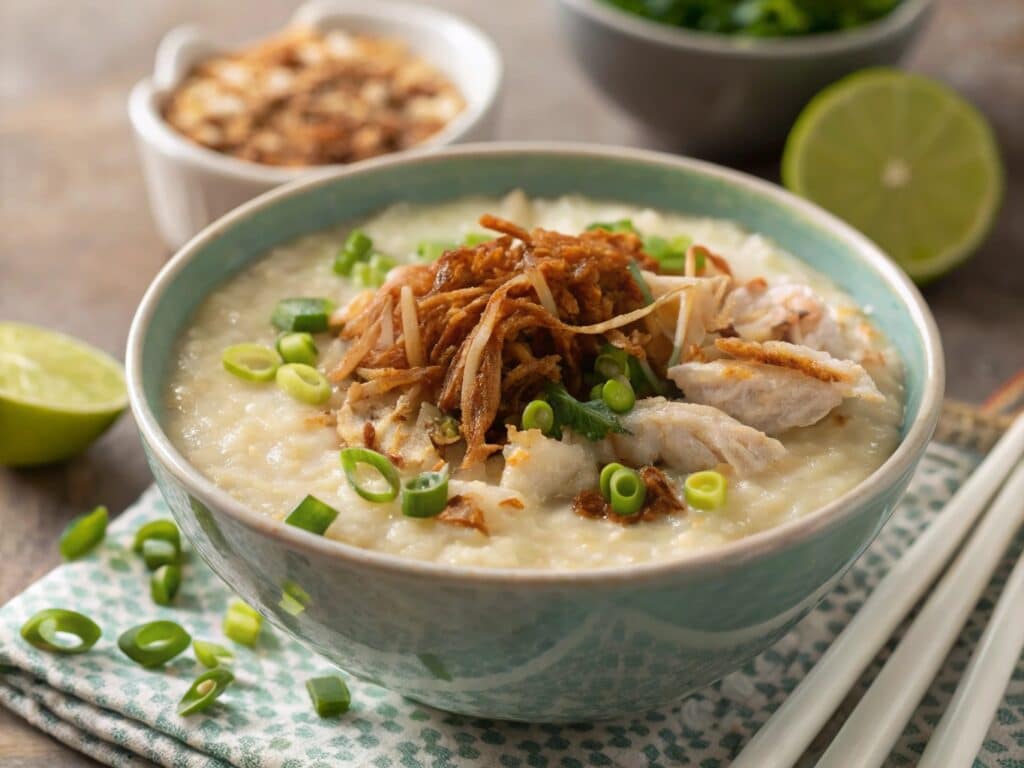
What is Vietnamese Congee (Cháo)?
Origins of Vietnamese Cháo and its Cultural Significance
In Vietnam, congee is called cháo, and it’s more than a simple rice dish it’s part of the country’s culinary soul. Rooted in both ancient and modern food culture, cháo appears in family breakfasts, hospital meals, street food stalls, and ancestral offerings. It’s commonly served to children, the elderly, and those recovering from illness, thanks to its gentle texture and digestibility.
Families often pass down their version of cháo whether it’s chicken-based or even seafood-rich making it a true comfort food with deep emotional connections.
How Cháo Differs from Chinese, Thai, or Japanese Congee
While cháo shares similarities with other Asian congee, it stands out in several ways:
| Feature | Vietnamese Cháo | Chinese Zhou | Thai Jok | Japanese Okayu |
|---|---|---|---|---|
| Texture | Thin, silky | Thicker, starchier | Thick with beef & egg | Light, watery |
| Broth Base | Chicken or fish | Water or stock | beef or chicken broth | Usually water only |
| Common Toppings | Scallions, fried shallots | Preserved egg, peanuts | Raw egg, ginger, lime | Umeboshi, seaweed |
Vietnamese cháo is often more fluid and broth-forward than its counterparts. It’s intentionally mild in flavor, meant to be customized with toppings and condiments.
Why Vietnamese Congee Is a Staple Comfort Food
There’s a reason cháo is the go-to dish in Vietnamese homes. It’s:
- Easy to digest – perfect for those with sensitive stomachs or kids.
- Affordable and versatile – can be made from simple pantry staples.
- Healing – commonly served with ginger and herbs for sick days.
- Customizable – build it up with proteins or keep it plain.
You’ll also find cháo at Vietnamese hospitals, temples, school cafeterias, and early-morning market stalls. It’s a humble dish that carries deep comfort, nourishment, and tradition.
Ingredients for Authentic Vietnamese Congee
Crafting the perfect bowl of Vietnamese congee begins with selecting the right ingredients. While cháo is humble at its core, the flavor hinges on thoughtful ingredient choices from the type of rice to the richness of your broth and the freshness of aromatics.
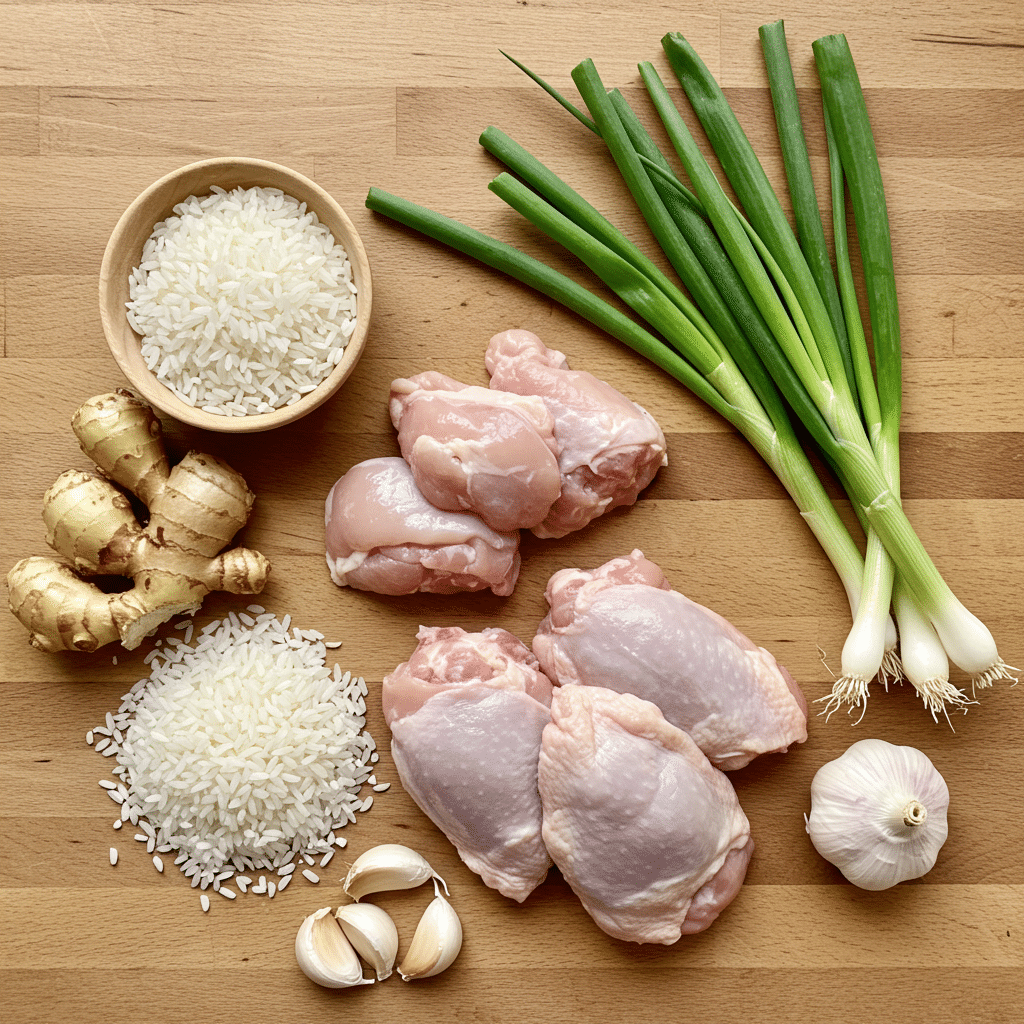
Rice: Types Used for the Best Texture
The base of any congee is rice, but not just any rice. For Vietnamese cháo, the goal is a smooth, almost creamy porridge without being gluey. Here’s how to choose:
| Rice Type | Texture Outcome | Best Use Case |
|---|---|---|
| Jasmine rice | Soft, slightly fragrant | Traditional cháo gà (chicken congee) |
| Broken rice (gạo tấm) | Silky and fast-cooking | Street-style congee in Vietnam |
| Short-grain white rice | Creamy and thick | Great for children or reheating later |
| Glutinous rice (nếp) | Sticky and dense | Used for sweet porridge, not savory |
Tip: Rinse the rice until water runs clear. Some cooks even lightly toast the rice for extra nuttiness before boiling.
Broth Base: Chicken and Vegetarian Variations
While you can use water, real Vietnamese congee shines when made with a rich broth:
- Chicken broth – Classic for cháo gà. Use bone-in chicken for maximum flavor.
- Beef bone broth– Hearty and collagen-rich. Ideal for cháo lòng (offal congee).
- Fish stock – Used in cháo cá, especially in coastal regions.
- Vegetable broth – Light and clean. A great base for vegan congee versions.
Must-Have Aromatics: Ginger, Garlic, Shallots
Vietnamese cháo is delicately flavored with fresh aromatics that boost digestion and warmth:
- Ginger – A must-have. Sliced or julienned, it soothes the stomach and adds sharpness.
- Garlic – Adds depth. Some recipes sauté garlic first in oil before adding rice.
- Shallots – Often fried until crispy and added as a topping for extra texture.
A pinch of salt and fish sauce is usually added early in cooking for a base umami layer, while white pepper and more fish sauce are added just before serving.
Optional Add-Ins: Century Egg, Duck, Offals
Want to make your cháo stand out or mirror street-style versions? Try these:
- Century egg – Rich, creamy yolk. Often used in Chinese-influenced Vietnamese cháo.
- Shredded duck – Common in cháo vịt, typically paired with fermented bean sauce.
- Tofu or mushrooms – Vegan options that hold up well in the broth.
Traditional Cooking Methods for Cháo
The beauty of Vietnamese congee lies in its simplicity, but don’t let that fool you it’s the cooking method that turns plain rice into a velvety, flavorful porridge. Whether you go old-school on the stovetop or modern with an Instant Pot, each method creates a different texture and depth of flavor.
Stovetop Slow-Simmer Method
This is the most traditional and widely used way of making cháo in Vietnam. While it takes time, the slow simmer allows the rice to break down gently and absorb the broth deeply.
Steps:
- Rinse 1 cup of rice thoroughly.
- In a large pot, add rice to 8–10 cups of chicken or beef broth.
- Add ginger slices and a pinch of salt.
- Bring to a boil, then lower heat and simmer uncovered for 1–1.5 hours.
- Stir occasionally to prevent sticking.
- Add shredded chicken the last 10 minutes.
Pro tip: The longer you simmer, the more silky your cháo becomes. If it thickens too much, just add water or broth to loosen it.
Pressure Cooker and Instant Pot Approach
Need a faster route to comfort? The Instant Pot is a game-changer for cháo lovers. It reduces the cooking time without sacrificing texture.
Steps:
- Rinse 1 cup of rice and add to Instant Pot with 6–8 cups of broth.
- Add ginger, garlic, and a dash of fish sauce.
- Close lid and cook on porridge mode or manually set to 25 minutes at high pressure.
- Let the pressure release naturally (10–15 minutes).
- Open, stir well, and adjust salt or water level if needed.
Instant Pot cháo tends to be slightly thicker. You can blend it briefly with a hand blender for an even creamier feel.
Rice-to-Water Ratio for Ideal Consistency
This is crucial. Too much water, and your congee will be flavorless. Too little, and it turns into sticky rice.
| Desired Consistency | Rice-to-Liquid Ratio |
|---|---|
| Loose, soup-like cháo | 1:9 or 1:10 |
| Standard cháo | 1:8 |
| Thick, spoonable porridge | 1:6 or 1:7 |
Note: These ratios apply to stovetop cooking. In Instant Pots, reduce liquid by about 20% due to sealed cooking.
Step-by-Step Vietnamese Congee Recipe
Now that you know the ingredients and cooking techniques, let’s put it all together. This authentic Vietnamese congee recipe is based on the classic cháo gà (chicken congee), a favorite in Vietnamese households for breakfast or recovery meals. It’s nourishing, comforting, and easily customizable.
Ingredients List with Measurements
| Ingredient | Amount | Notes |
|---|---|---|
| Jasmine rice | 1 cup | Rinsed thoroughly |
| Chicken (bone-in thigh or breast) | 2 pieces | Or substitute with rotisserie chicken |
| Chicken broth | 8–10 cups | Homemade or low-sodium store-bought |
| Ginger | 3–4 slices | Peeled and smashed |
| Garlic | 2 cloves | Minced |
| Shallots (optional) | 1–2 | Thinly sliced |
| Fish sauce | 1–2 tbsp | Adjust to taste |
| Salt | ½ tsp | Or to taste |
| White pepper | ¼ tsp | Optional |
| Scallions | 2 stalks | Finely chopped |
| Fried shallots | 2 tbsp | For topping |
| Fresh cilantro (optional) | To garnish | Optional |
| Youtiao (Chinese cruller) | Optional | For dipping |
Detailed Cooking Instructions
Stovetop Method
- In a large pot, bring the broth to a boil.
- Add the rinsed rice, ginger slices, and chicken pieces.
- Reduce heat to a low simmer. Let it cook uncovered for 60–75 minutes.
- Stir occasionally to prevent sticking to the bottom.
- Once rice breaks down and reaches a porridge-like texture, remove chicken.
- Shred the chicken and return to the pot.
- Stir in fish sauce, salt, and white pepper.
- Simmer for another 10 minutes, adjusting broth or water if needed.
Instant Pot Method
- Add rice, chicken, ginger, and broth to the pot.
- Cook on Porridge setting or manually on high pressure for 25 minutes.
- Let the pressure release naturally (about 15 minutes).
- Shred the chicken, return to the pot, season, and stir well.
Tips for Adjusting Thickness & Texture
- Too thick? Add more hot water or broth, then simmer for 5 minutes.
- Too watery? Simmer uncovered to reduce.
- Want it extra smooth? Use a ladle or immersion blender to break up the rice further.
Pro Tip: The flavor gets better the next day. Cháo thickens in the fridge, so add broth when reheating.
Popular Variations of Vietnamese Congee
One of the best things about Vietnamese congee (cháo) is its versatility. From comforting chicken to bold duck or seafood, there’s a version of cháo for every mood, season, and appetite. Each variation offers a new way to enjoy the silky rice porridge while staying rooted in tradition.
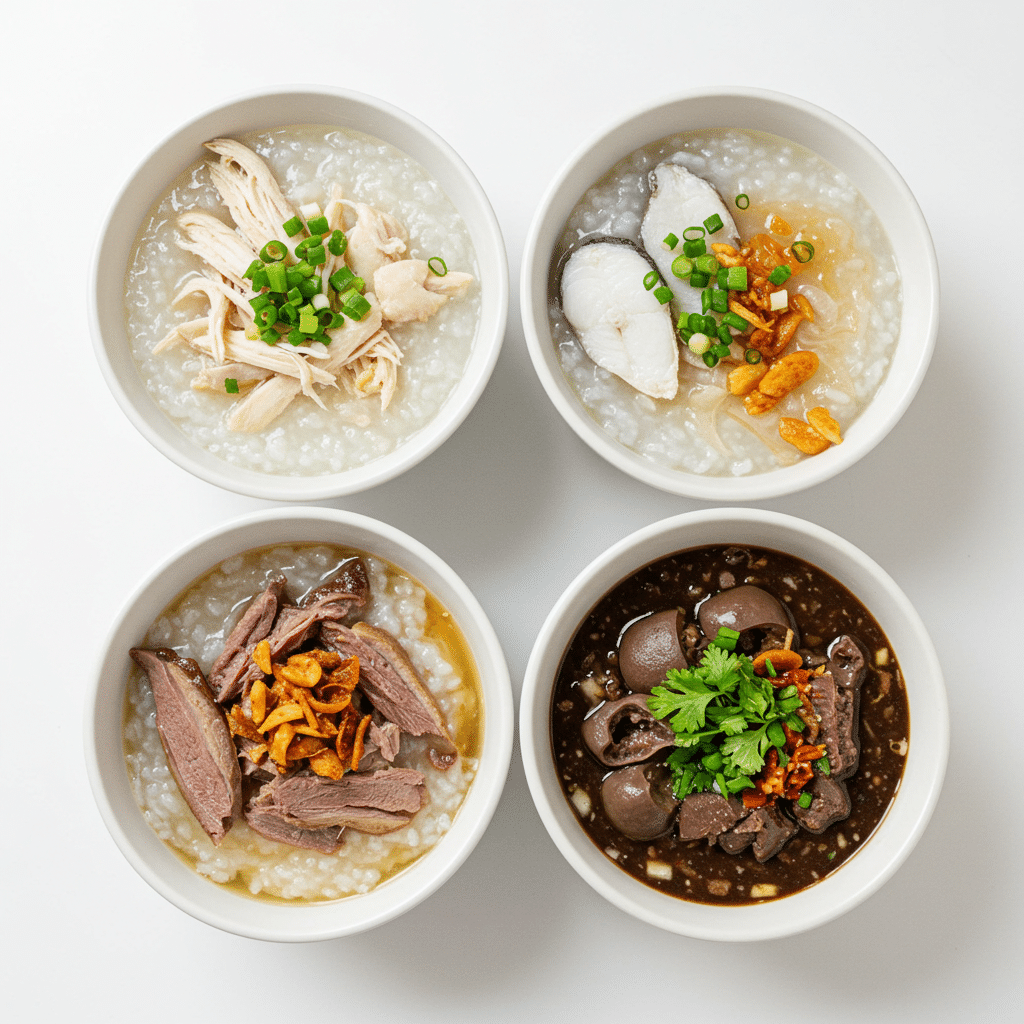
Cháo Gà (Chicken Congee)
This is the most beloved and commonly made variation. Cháo gà is comforting, light, and deeply nourishing. Traditionally served with shredded poached chicken, it’s flavored with ginger, scallions, fish sauce, and white pepper.
Best for: Sick days, cold mornings, or light dinners.
Cháo Vịt (Duck Congee)
Cháo vịt features shredded duck meat cooked in a duck broth that’s rich and slightly gamey. It’s often served with gỏi vịt (duck salad) and fermented bean sauce (tương gừng), which adds tang and umami.
Pro tip: Vietnamese people love dipping pieces of duck into ginger sauce between spoonfuls of congee.
Cháo Lòng (Organ Meat Congee – Pork-Free Version)
Try this hearty version using chicken gizzards, chicken liver, beef liver, or even tofu for a vegetarian twist. It maintains the bold texture and flavor without pork.
Best served with: Fresh herbs, fried shallots, and a squirt of lime.
Other Regional or Creative Variations
- Cháo trai: Made with freshwater clams. Light and slightly briny.
- Cháo bò: Ground beef or beef bones. More common in central Vietnam.
- Vegetarian cháo: Uses mushrooms, tofu, or lotus seeds with vegetable broth.
No matter which version you choose, cháo remains a canvas for regional flavors and personal preferences.
Toppings and Side Dishes to Elevate Your Cháo
Cháo, by itself, is warm and soothing but when paired with the right toppings and sides, it becomes a flavorful feast. These additions bring crunch, spice, freshness, and umami, turning a simple bowl of Vietnamese congee into something unforgettable.
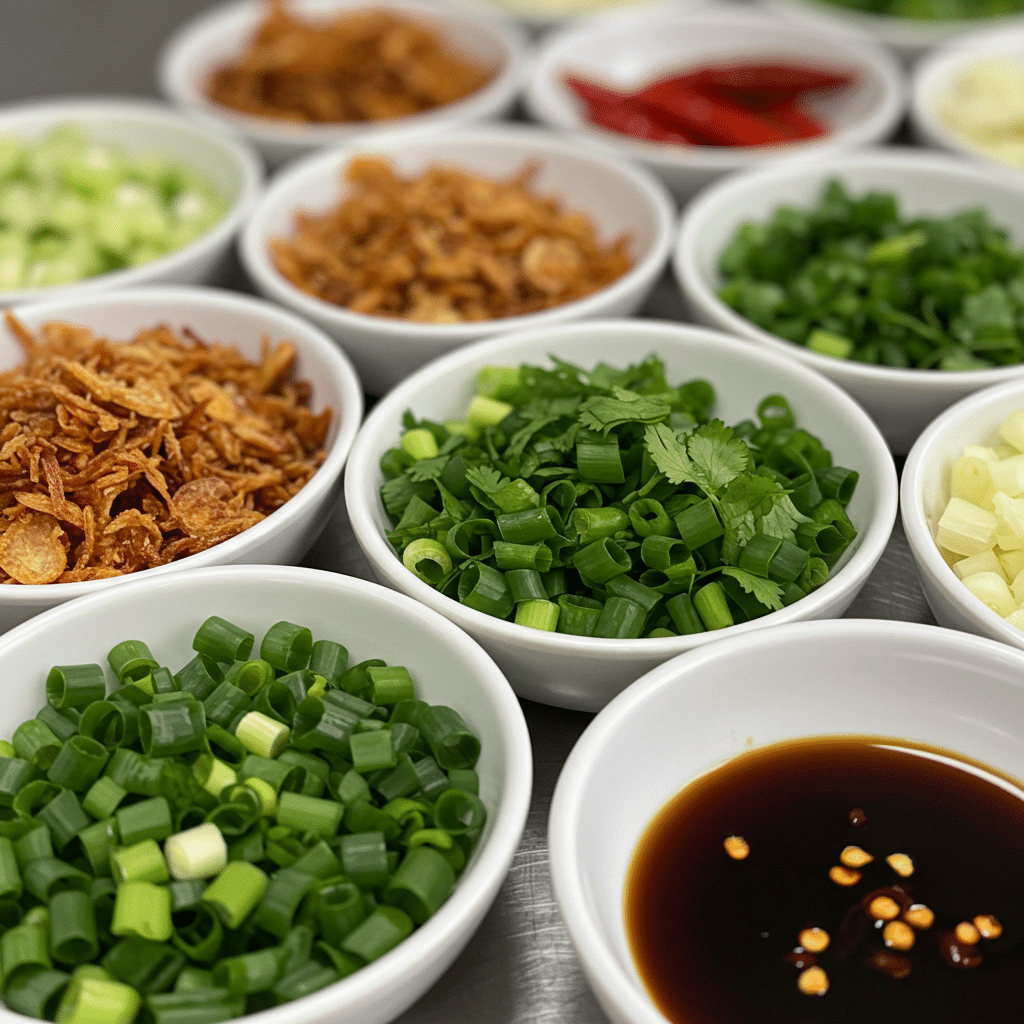
Fried Shallots, Scallions, Pepper, and Herbs
These toppings are non-negotiable in Vietnamese cháo culture. They not only add layers of flavor but also a bit of texture and aroma.
- Fried shallots (hành phi): Crispy, sweet-savory flakes that sit beautifully on top.
- Scallions: Chopped green onions provide sharpness and color.
- Cilantro or Vietnamese coriander (rau răm): Adds freshness and a hint of citrus.
- White or black pepper: Sprinkled on top for gentle heat.
- Chili oil or fresh chopped chilies: Optional for those who love a spicy kick.
Youtiao (Fried Breadstick) and Pickled Veggies
These sides are not traditionally Vietnamese but are popular additions, especially with cháo in urban eateries or Chinese-Vietnamese households.
- Youtiao (dầu cháo quẩy): Long, deep-fried dough sticks, torn into chunks and dipped into hot cháo for contrast in texture.
- Pickled mustard greens (dưa cải chua): Tangy and crunchy, they cut through the richness.
- Carrot and daikon pickle (đồ chua): A side that brings brightness and balance.
Check out Tortilla Cinnamon Rolls to follow your cháo with a light, sweet snack.
Best Sauces to Pair With Congee
Sauces let you customize your cháo bowl bite-by-bite. In Vietnam, it’s normal to see a sauce tray alongside your cháo bowl.
- Fish sauce (nước mắm): Drizzle over the top or dip meat into it.
- Soy sauce: A neutral, salty kick.
- Fermented bean sauce (tương): Especially served with cháo vịt (duck).
- Chili paste or sriracha: Adds both color and heat.
- Lime wedges: A squeeze wakes everything up.
Don’t miss our No Bake Chocolate Oat Bars for a make-ahead treat after a hearty cháo dinner.
Nutritional Benefits of Vietnamese Congee
Often served to those recovering from illness or looking for a gentle meal, Vietnamese congee isn’t just easy on the stomach it’s packed with health benefits that make it a smart choice for any time of day. Whether you’re watching your calorie intake, need gut-friendly food, or want something nourishing, cháo fits the bill.
Easy on Digestion: Perfect for Sick Days
Cháo is famously gentle on the digestive system. Since it’s cooked slowly and with plenty of liquid, the rice breaks down into a smooth, hydrating porridge, making it perfect for:
- Kids, seniors, and anyone with weak digestion
- Post-surgery meals or flu recovery
- Soothing upset stomachs and reducing nausea
Adding ginger boosts digestion even more it’s an ingredient with natural anti-inflammatory properties.
Nutrient Profile: Protein, Fiber, and Electrolytes
The base ingredients in cháo can be highly nutritious when built thoughtfully:
| Nutrient | Found In | Benefits |
|---|---|---|
| Protein | Chicken, duck, fish, tofu | Muscle repair, satiety |
| Fiber | Brown rice, vegetables, herbs | Aids digestion and gut health |
| Electrolytes | Broth (especially homemade) | Hydration, especially helpful when sick |
| Antioxidants | Garlic, ginger, scallions | Immunity support, anti-inflammatory |
Even with minimal ingredients, cháo can be fortified with toppings and broth to become a complete, well-rounded meal.
Looking for more nutrition-packed comfort? Try Best Recipe Juice Citrus to pair with your bowl of cháo.
Low-Calorie, Gluten-Free, and Gut-Friendly
- Low-Calorie: A cup of plain cháo can have under 150 calories.
- Gluten-Free: Made from rice, it’s naturally free from wheat.
- Customizable: Add lean protein and vegetables to build a meal that meets dietary needs.
- Hydrating: Thanks to its high water content, it also helps with hydration.
Whether you’re recovering, cleansing, or just craving something wholesome, cháo delivers nutrition and comfort in every spoonful.
Vietnamese Congee vs Other Asian Porridges
Across Asia, rice porridge is a beloved comfort food but not all porridges are the same. From China to Japan to Thailand, each culture has its own version. So how does Vietnamese congee, or cháo, stand out? Let’s break it down.
Cháo vs Chinese Zhou vs Japanese Okayu
These are the most well-known rice porridges, but each one has unique ingredients, textures, and traditions.
| Feature | Vietnamese Cháo | Chinese Zhou | Japanese Okayu |
|---|---|---|---|
| Rice Texture | Thin, broth-heavy, silky | Thick, starch-rich | Light, watery |
| Flavor Base | Chicken/beef broth, fish sauce | Water, often with century egg or peanuts | Plain or lightly salted water |
| Toppings | Scallions, herbs, fried shallots | Preserved eggs, beef, peanuts | Pickled plum, nori |
| Serving Purpose | Breakfast or recovery food | Everyday meal, often savory | Often eaten when ill |
Vietnamese cháo leans lighter in flavor but is highly customizable, making it a perfect base for rich toppings or bold side dishes.
Don’t miss our Carrot Cake Cookies Recipe for a sweet bite after comparing all those porridges!
Cháo vs Thai Jok and Korean Juk
Beyond China and Japan, other cultures have their own take on congee:
- Thai Jok: Made with meat-based congee, often includes a raw egg stirred in and topped with ginger and vinegar. It’s thick and hearty, often seasoned heavily.
- Korean Juk: Can be sweet or savory. Uses sesame oil and may include ingredients like abalone, pumpkin, or red beans.
In contrast, Vietnamese congee is cleaner and more herbal, usually garnished with scallions, cilantro, and fried shallots. The use of fish sauce rather than soy sauce gives it that signature Vietnamese flavor.
What Sets Cháo Apart in Flavor & Cooking
Vietnamese cháo is defined by a few key characteristics:
- More liquid-to-rice ratio for a soupier consistency.
- Aromatic base with garlic, shallots, and ginger.
- Use of bone broth especially chicken for richness.
- Custom condiments like lime, chili, or fermented bean sauce.
Whether you’re new to cháo or grew up eating it, this congee is distinctly Vietnamese and delicious in its own right.
Serving, Storage & Reheating Tips
You’ve made a perfect pot of Vietnamese congee, but what’s next? The way you serve, store, and reheat cháo can make a big difference in flavor and texture especially if you’re preparing it ahead or enjoying leftovers.
How to Serve Cháo the Vietnamese Way
Presentation and accompaniments matter, even for a humble dish like cháo. Here’s how it’s typically served in Vietnamese households and street stalls:
- Ladle hot cháo into individual bowls thinner than oatmeal, more broth than mush.
- Add protein (shredded chicken or fish) on top.
- Sprinkle with fried shallots, chopped scallions, and fresh cilantro.
- Offer condiments at the table: fish sauce, lime wedges, chili, and pepper.
- Optional sides: youtiao (fried breadsticks), pickled veggies, or even a boiled egg.
This flexible format makes it easy for everyone to season their own bowl just the way they like it.
Best Practices for Storing Leftovers
Congee stores well, but it thickens as it cools, so keep that in mind.
| Storage Tip | Instructions |
|---|---|
| Refrigeration | Store in airtight containers for up to 4 days |
| Portioning | Store in single-serving portions for easy reheating |
| Freezing (optional) | Freeze up to 1 month; defrost slowly in the fridge |
If you made a large batch, consider storing the rice base and proteins separately to keep the texture right and avoid overcooking the meat on reheating.
Reheating Without Losing Texture or Flavor
Cháo can turn gelatinous or too thick from the starch, so you’ll want to bring it back to that silky texture:
- Add water or broth to loosen it (about ¼ cup per cup of cháo).
- Reheat slowly over low heat, stirring frequently.
- Taste and adjust seasoning again, as flavors may mellow during storage.
Check out Easy Mocktail Recipes for a refreshing, non-alcoholic drink to serve with reheated cháo.
Conclusion Vietnamese Congee
Vietnamese congee, or cháo, is more than just a bowl of rice porridge it’s a dish packed with cultural tradition, flavor, and comfort. From classic cháo gà to the adventurous cháo lòng, there’s a version for every palate. It’s easy to make, incredibly forgiving, and endlessly adaptable.
Whether you’re cooking for family, feeding someone on the mend, or simply seeking a cozy bowl of nourishment, cháo delivers. And once you’ve mastered the base, the possibilities for toppings, sides, and variations are endless.
Learn more about Recipe Homemade Coffee Creamer for another easy-to-make kitchen staple that complements breakfast dishes like cháo.
FAQs Vietnamese Congee
What is congee called in Vietnam?
In Vietnam, congee is called cháo. It’s a soft, rice-based porridge typically served hot with savory toppings like chicken, beef, or fish. It’s a beloved comfort food eaten for breakfast or when someone is feeling unwell.
What is the difference between Cháo and congee?
Congee is a general term used to describe rice porridge across many Asian cultures. Cháo is the Vietnamese version, usually thinner in texture and made with a flavorful broth, fresh herbs, and traditional Vietnamese seasonings like fish sauce and fried shallots.
What is Vietnamese porridge made of?
Vietnamese porridge is made of white rice simmered in broth (chicken, beef, or fish) until it breaks down into a smooth, soupy consistency. Aromatics like ginger, garlic, and scallions are commonly added, along with proteins such as shredded chicken or beef.
Is congee just overcooked rice?
Not exactly. While it may look like overcooked rice, congee is intentionally slow-cooked in a generous amount of water or broth to achieve its signature smooth, creamy texture. It’s a purposeful and comforting dish, not a kitchen accident.
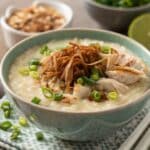
Vietnamese Congee (Cháo Gà) – Traditional Chicken Rice Porridge
- Total Time: 1 hour 10 minutes
- Yield: 4 servings 1x
- Diet: Gluten Free
Ingredients
-
1 cup jasmine rice (rinsed)
-
8–10 cups chicken broth (or beef/vegetable for variation)
-
2 bone-in chicken thighs or 1 chicken breast
-
3 slices fresh ginger
-
2 garlic cloves, minced
-
2 tbsp fish sauce (adjust to taste)
-
½ tsp salt
-
¼ tsp white pepper (optional)
-
2 scallions, chopped
-
2 tbsp fried shallots (for topping)
-
Fresh cilantro (optional)
-
Lime wedges (to serve)
-
Optional: cooked chicken gizzards, liver, or tofu for offal variation
Instructions
-
In a large pot, bring the broth to a boil.
-
Add rice, ginger slices, chicken pieces, and salt.
-
Lower heat and simmer uncovered for 60–75 minutes, stirring occasionally.
-
Once rice breaks down and reaches a porridge consistency, remove chicken.
-
Shred the chicken and return to the pot.
-
Stir in fish sauce and pepper. Simmer 10 minutes more. Adjust liquid as needed.
-
Serve hot, garnished with scallions, fried shallots, cilantro, and a squeeze of lime.
Notes
-
Adjust consistency with more broth or water.
-
Can be made vegetarian using mushroom broth and tofu.
-
Great for leftovers – store refrigerated up to 4 days.
- Prep Time: 10 minutes
- Cook Time: 60 minutes
- Category: Lunch & Dinner
- Method: Stovetop
- Cuisine: Vietnamese
Nutrition
- Serving Size: 1 bowl (¼ recipe)
- Calories: ~190 kcal
- Sugar: ~1g
- Sodium: ~750mg (varies with broth/fish sauce)
- Fat: ~5g
- Saturated Fat: ~1g
- Unsaturated Fat: ~4g
- Trans Fat: 0g
- Protein: ~15g
